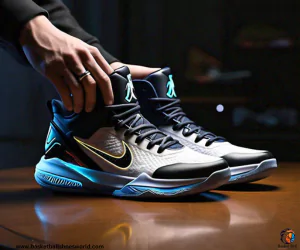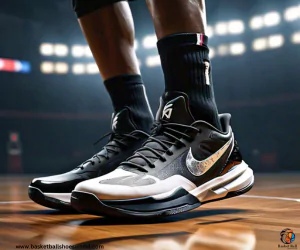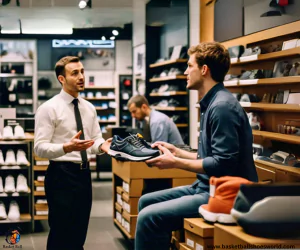Do you want to replace or purchase a new pair of basketball shoes? Choosing the right basketball shoes goes beyond just picking a stylish pair. It’s an investment in your performance, comfort, and potentially, injury prevention.
Here’s why understanding shoe selection matters: Basketball places immense stress on your feet and ankles. The right shoes, tailored to your playing style and court surface, provide crucial support and traction.
This guide dives deep into the key features to consider when selecting basketball shoes, empowering you to make an informed decision.
Table of Contents
How do playing Styles & Positions Influence Basketball Shoe Selection?

Basketball isn’t a one-size-fits-all sport, and neither are basketball shoes. Different playing styles require different footwear features. Here’s a breakdown of key player positions and their ideal shoe characteristics:
1. Guards:
Why are speed & agility crucial? For the swift and agile guards, the game is all about speed and precision. Low-top shoes offer the flexibility and lightness required for such movements.
But what features should guards look for when buying basketball shoes? They should prioritize shoes with excellent traction for quick cuts, a snug fit to prevent slippage, and responsive cushioning to stay on their toes.
2. Forwards:
Forwards are the versatile powerhouses of the team, blending speed with strength. Mid-top shoes provide the necessary ankle support without restricting movement, offering a sweet spot for these all-rounders.
What are the buying tips for forwards when choosing basketball shoes? Look for shoes that offer stability for sudden changes in direction and are versatile enough to accommodate both inside and outside play.
3. Centers:
What Makes Power & Rebounding Essential? Centers dominate the paint with their power plays and rebounding prowess. High-top shoes with ample cushioning and support are ideal for these court giants.
What should centers consider when purchasing basketball shoes? They should focus on durability to withstand the physicality of the post, a secure fit to prevent foot shifting, and strong ankle support to protect against injuries.
How Does the Court Surface Impact Shoe Choice?

The court surface you play on significantly impacts your shoe choice. Here’s how to choose footwear that optimizes your performance on different terrains:
1. Indoor Courts: Why Are Traction & Clean Cuts Important?
Indoor courts, like those used biggest shoe size in the NBA, have smooth wooden surfaces that demand excellent traction. The polished floors of indoor courts demand shoes with a herringbone outsole pattern, which provides a superior grip to prevent slipping and sliding.
2. Outdoor Courts: How Do Durability & Thicker Soles Come into Play?
Outdoor courts, often used in high school and NCAA games, are typically made of asphalt or concrete. These surfaces are more abrasive and require shoes built for durability. Opt for shoes with thicker soles and tougher materials to withstand wear and tear.
The rough and unforgiving outdoor surfaces call for shoes that can withstand abrasion, with thicker soles for extra protection and longevity.
What Are the Different Types and Parts of a Basketball Shoe?

Demystifying the anatomy of Best Basketball Shoes for Small Forwards can empower players to make informed choices.
1. The Upper: How Do Material Choices Affect Performance?
The upper part of the shoe wraps around your foot and provides support. composed of materials like leather, synthetic, or mesh, affects the shoe’s durability, support, and breathability. Leather offers a classic look and durability, synthetic materials provide structured support, and mesh ensures maximum breathability for those intense moments on the court.
2. The Midsole: Why Are Cushioning and Impact Protection Vital?
The midsole is the heart of the shoe’s comfort and performance, where technologies like air and foam come into play to provide shock absorption and responsiveness. This is where brands showcase their latest innovations in cushioning systems, each with unique attributes to enhance the playing experience.
3. The Outsole: How Does Pattern Affect Traction?
The outsole’s pattern, such as herringbone or concentric circles, determines the shoe’s grip on the court surface. Players should choose a pattern that matches their playing style and court type, ensuring they have the traction needed for their signature moves.
How Should Basketball Shoes Fit for Optimal Performance?

A shoe that fits well is a shoe that performs well. Fit & Comfort: What Constitutes the Right Fit? Proper sizing, width, and secure lockdown are essential for comfort and injury prevention. The right fit means no excess space at the toe and a heel that doesn’t slip, with laces that provide a secure, adjustable lockdown.
1. Fit is King: Comfort and Security Go Hand-in-Hand

Your shoes should fit snugly but comfortably, with enough room for your toes to wiggle. Look for features like a secure lacing system and a comfortable heel cup to prevent slippage.
Breathability is also important to keep your feet cool and dry during intense games. Allow some break-in time for new shoes as the materials adjust to your feet.
2. Look for Essential Features for Peak Performance:

Cushioning: Cushioning technologies like air and foam enhance performance by providing responsive cushioning that returns energy with every step.
Traction: The right outsole pattern ensures you can change direction and stop on a dime without slipping.
Ankle Support: Traction patterns and ankle support vary depending on the shoe’s design and the player’s needs. With high-tops offering the most support and low-tops the greatest flexibility. and mid-tops make a balance between low tops and high tops.
How Does Brand Reputation Influence Basketball Shoe Selection?
In a market flooded with options, a brand’s reputation can be a beacon of quality and innovation.
Why Are Reviews & Recommendations Critical in the Buying Process?
They offer insights from other players and experts, providing a real-world perspective on the shoe’s performance.
Price & Value: How to Find the Best Deal?
Consider the features you need and compare prices to find the best value for your money, without compromising on shoe quality.
Where Can You Get Professional Fitting and Guidance?

Don’t hesitate to seek expert advice at a sporting goods store or consult reputable online retailers for a wide selection of basketball shoes. They can provide personalized recommendations based on your playing style and needs. By the way, our team also suggests you choose the best basketball shoes offers according to your playing style and needs. Fill out the Contact Us form now.
Bonus Sections: How Do Shoes Impact Player Confidence?
- SNEAKER AESTHETICS: LOOK GOOD, PLAY GOOD: Basketball shoes purchase have become a fashion statement as well as a performance tool. Explore various styles to find shoes that express your personality on and off the court.
- How Basketball Shoes Break In: A proper break-in can enhance comfort and performance, ensuring the shoes conform to your feet’s unique contours. Here are tips to make the break-in period more comfortable, such as wearing them for short periods at first and gradually increasing wear time.
- Basketball Shoe Weight: A Balancing Act: Lighter shoes generally offer better agility, while heavier shoes might provide more stability. Consider your playing style and preferences when evaluating shoe weight.
- How Do You Know Which Basketball Shoes Are Best?: The “best” shoe depends on the individual! There’s no one-size-fits-all answer. By considering your playing style, court surface, and desired features, you can find the perfect pair to elevate your game.
Conclusion
Selecting the right basketball shoes is essential for performance, comfort, and injury prevention. It’s a decision that can influence every jump, sprint, and pivot. Take the time to find the perfect pair that suits your needs and enhances your game, and step onto the court with confidence.






